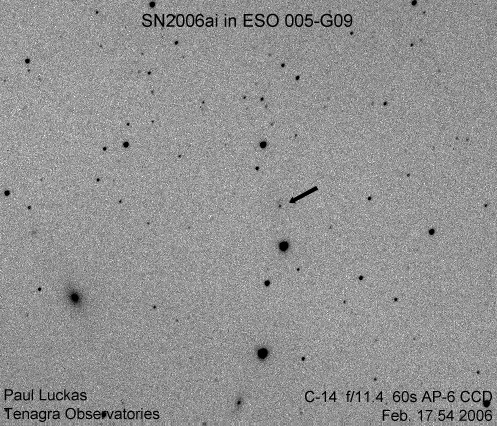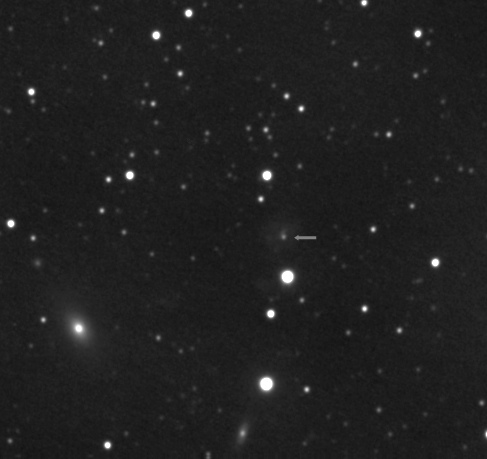Home
Supernova 2006ai in ESO 005-G09
RA: 7h 29m 53.77s.. DEC: -84° 02' 18.7" ( J2000 )

|
ESO 005-G09 in Octans
Dist. ?? million l.y. (?)
Supernova Mag 16.2CR
Date : Feb. 17.54 2006
Exposure time : 60 sec.
0.35m f/11.4 AP-6 CCD
|

|
Supernova Mag 16.0CR
Date : Feb. 19.52 2006
Exposure time : 7 x 2min.
|
Photometry reference image.
IAU Circulars & Type determination for SN 2006ai
Electronic Telegram No. 406
Central Bureau for Astronomical Telegrams
INTERNATIONAL ASTRONOMICAL UNION
M.S. 18, Smithsonian Astrophysical Observatory, Cambridge, MA 02138,
U.S.A.
IAUSUBS@CFA.HARVARD.EDU or FAX 617-495-7231 (subscriptions)
CBAT@CFA.HARVARD.EDU (science)
URL http://cfa-www.harvard.edu/iau/cbat.html
SUPERNOVA 2006ai IN ESO 5-G9
P. Luckas, Perth, W. Australia; O. Trondal, Oslo, Norway; and
M. Schwartz, Patagonia, AZ, report the discovery of an apparent
supernova on unfiltered CCD frames taken with the 0.35-m Tenagra
telescope at Perth on Feb. 17.54 (at mag 16.2) and 19.52 UT (mag
16.0) in the course of the Tenagra Observatory Supernova Search.
SN 2006ai is located at R.A. = 7h29m52s.16, Decl. = -84o02'20".5
(equinox 2000.0), which is 2".5 west and 1".8 south of the center
of ESO 5-G9 (which itself has position end figures 29m53s.77,
02'18".7). Nothing was visible at the position of 2006ai on an
image taken by Luckas on 2005 Dec. 16.79 (limiting magnitude about
18.5).
NOTE: These 'Central Bureau Electronic Telegrams' are sometimes
superseded by text appearing later in the printed IAU Circulars.
(C) Copyright 2006 CBAT
2006 February 19 (CBET 406) Daniel W. E.
Green
Circular No. 8674
Central Bureau for Astronomical Telegrams
INTERNATIONAL ASTRONOMICAL UNION
Mailstop 18, Smithsonian Astrophysical Observatory, Cambridge, MA 02138, U.S.A.
IAUSUBS@CFA.HARVARD.EDU or FAX 617-495-7231 (subscriptions)
CBAT@CFA.HARVARD.EDU (science)
URL http://cfa-www.harvard.edu/iau/cbat.html ISSN 0081-0304
Phone 617-495-7440/7244/7444 (for emergency use only)
SUPERNOVAE 2006ae, 2006af, 2006ag, 2006ah, 2006ai
Several apparent supernovae have been discovered on CCD images
(all unfiltered except for the spectroscopic SDSS discoveries):
2006ae and 2006af by M. SubbaRao and the Sloan Digital Sky Survey
(SDSS) collaboration (cf. IAUC 8668, CBET 400; magnitudes below are
estimated r-band values; both objects at center of their host
galaxies); 2006ag and 2006ah on Palomar NEAT survey images via the
"Nearby Supernova Factory" collaboration (details on CBET 402); and
2006ai by P. Luckas, O. Trondal, and M. Schwartz (cf. IAUC 8668).
SNe 2006ae, 2006af, and 2006ah all appear to be type-Ia supernovae
within a weak of maximum light upon discovery, while 2006ag is a
type-IIn event. Additional approximate magnitudes of 2006ai in ESO
5-G9: 2005 Dec. 16.79 UT, [18.5; 2006 Feb. 19.52, 16.0.
SN 2006 UT R.A. (2000.0) Decl. Mag. Offset
2006ae Feb. 2.51 14 48 23.27 +21 47 51.5 20.7 -
2006af Feb. 4.38 10 33 57.18 +20 20 25.7 19.5 -
2006ag Feb. 9.4 12 00 17.12 +28 36 22.0 17.9 -
2006ah Feb. 9.6 13 46 13.71 - 9 07 50.6 18.6 -
2006ai Feb. 17.54 7 29 52.16 -84 02 20.5 16.2 2".5 W, 1".8 S
GRB 060218 = SUPERNOVA 2006aj
A. Soderberg, California Institute of Technology; E. Berger,
Observatories of the Carnegie Institution of Washington; and B.
Schmidt, Australian National University, report that a spectrogram
(range 320-1000 nm) of GRB 060218 (cf. Cusumano et al., GCN
Observation Report Circ. 4775; R.A. = 3h21m37s, Decl. = +16o51'58",
equinox 2000.0), obtained with Gemini-South telescope (+ GMOS) on
Feb. 21.024 UT, shows that underlying a power-law continuum are
features consistent with a broad-lined type-Ib/c supernova
(designated 2006aj) near maximum light, confirming the findings of
Masetti et al. (GCN 4803). The Gemini-South spectrum also confirms,
from several narrow emission lines, the redshift of z = 0.033
(Mirabal, who reported r = 17.6 on Feb. 19.1438 via GCN 4784, and
who notes a pre-outburst extended object at the GRB location via
GCN 4783). Marshall et al. provide a precise position of the
optical counterpart of GRB 060218 from images obtained with the
Swift UltraViolet and Optical Telescope: R.A. = 3h21m39s.71, Decl.
= +16o52'02".6 (estimated 1-sigma error about 1".0; cf. GCN 4779).
Zheng et al. report (on GCN 4802) the following R magnitudes for
the optical counterpart of GRB 060218: Feb. 18.4522, 17.8; 20.4471,
18.2.
(C) Copyright 2006 CBAT
2006 February 21 (8674) Daniel W. E. Green
Electronic Telegram No. 422
Central Bureau for Astronomical Telegrams
INTERNATIONAL ASTRONOMICAL UNION
M.S. 18, Smithsonian Astrophysical Observatory, Cambridge, MA 02138,
U.S.A.
IAUSUBS@CFA.HARVARD.EDU or FAX 617-495-7231 (subscriptions)
CBAT@CFA.HARVARD.EDU (science)
URL http://cfa-www.harvard.edu/iau/cbat.html
SUPERNOVAE 2006Y AND 2006ai
N. Morrell and G. Folatelli, on behalf of the Carnegie Supernova
Project, report that spectroscopy (range 380-930 nm) of SN 2006Y (cf.
IAUC 8668), obtained on Feb. 27.14 UT with the Las Campanas 2.5-m du
Pont telescope (+ WFCCD spectrograph), showing it to be a type-II
event, nearly one month after explosion. A spectrum of the apparent
nucleus of the host galaxy was also obtained, from which is derived a
recession velocity of 10074 km/s (redshift 0.0336 +/- 0.0001). From
nebular emission lines superimposed on the supernova spectrum, a
slightly different redshift of 0.0333 +/- 0.0001 is derived; using
this value, an expansion velocity of 7650 km/s for this supernova is
derived from the minimum of the H_beta absorption. A redshift of
0.0341 +/- 0.0002 was also measured for ESO 207-G27 (a galaxy located
southeast of the supernova host).
A spectrum of SN 2006ai (cf. IAUC 8674), obtained on Mar. 5.12 with
the same instrumental configuration, shows it to be a type-II supernova,
at least one month after explosion, for which an expansion velocity of
8050 km/s is derived from the minimum of the H_beta absorption,
considering a redshift of 7426 km/s (z = 0.0158 +/- 0.0001) measured
from emission lines in the spectrum of the host galaxy.
NOTE: These 'Central Bureau Electronic Telegrams' are sometimes
superseded by text appearing later in the printed IAU Circulars.
(C) Copyright 2006 CBAT
2006 March 7 (CBET 422) Daniel W. E.Green

